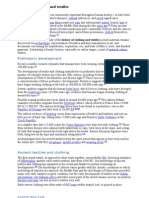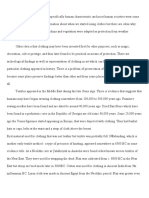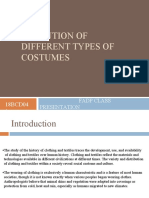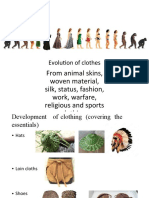0 ratings0% found this document useful (0 votes)
22 viewsThe History of Fashion
The History of Fashion
Uploaded by
pinasafThe document discusses the history of fashion from ancient times to the 19th century. It describes how early humans made clothing from animal skins and plant materials for protection. Over thousands of years, techniques like weaving, spinning, and dyeing developed. Ancient civilizations like Egypt, Greece, and Rome influenced fashion. Regional styles emerged as European settlers went to America. Fashion changed slowly until the 14th century when styles became more fitted. Influences on fashion included trade, politics, religion, and technology.
Copyright:
© All Rights Reserved
Available Formats
Download as PPT, PDF, TXT or read online from Scribd
The History of Fashion
The History of Fashion
Uploaded by
pinasaf0 ratings0% found this document useful (0 votes)
22 views12 pagesThe document discusses the history of fashion from ancient times to the 19th century. It describes how early humans made clothing from animal skins and plant materials for protection. Over thousands of years, techniques like weaving, spinning, and dyeing developed. Ancient civilizations like Egypt, Greece, and Rome influenced fashion. Regional styles emerged as European settlers went to America. Fashion changed slowly until the 14th century when styles became more fitted. Influences on fashion included trade, politics, religion, and technology.
Original Description:
fashion evolution
Original Title
fashion
Copyright
© © All Rights Reserved
Available Formats
PPT, PDF, TXT or read online from Scribd
Share this document
Did you find this document useful?
Is this content inappropriate?
The document discusses the history of fashion from ancient times to the 19th century. It describes how early humans made clothing from animal skins and plant materials for protection. Over thousands of years, techniques like weaving, spinning, and dyeing developed. Ancient civilizations like Egypt, Greece, and Rome influenced fashion. Regional styles emerged as European settlers went to America. Fashion changed slowly until the 14th century when styles became more fitted. Influences on fashion included trade, politics, religion, and technology.
Copyright:
© All Rights Reserved
Available Formats
Download as PPT, PDF, TXT or read online from Scribd
Download as ppt, pdf, or txt
0 ratings0% found this document useful (0 votes)
22 views12 pagesThe History of Fashion
The History of Fashion
Uploaded by
pinasafThe document discusses the history of fashion from ancient times to the 19th century. It describes how early humans made clothing from animal skins and plant materials for protection. Over thousands of years, techniques like weaving, spinning, and dyeing developed. Ancient civilizations like Egypt, Greece, and Rome influenced fashion. Regional styles emerged as European settlers went to America. Fashion changed slowly until the 14th century when styles became more fitted. Influences on fashion included trade, politics, religion, and technology.
Copyright:
© All Rights Reserved
Available Formats
Download as PPT, PDF, TXT or read online from Scribd
Download as ppt, pdf, or txt
You are on page 1of 12
The History of Fashion
The Earliest Clothing
Thousands of years ago people learned to
make clothing from natural resources as
protection from the weather.
– Animal skins & hair
– Plants
– Grasses
– Tree bark
How do we know? Cave and tomb
drawings and ancient sculptures.
First Clothes & Fabrics
Simple in structure & design
Varied from region to region
Fragments of textiles date back to 7500 B.C.
Linen cloth was made from flax plants by
Egyptians in 5000 B.C
Thousands of years later inhabitants of
India, Pakistan, and possibly Americans
made fabric of cotton
Fashions of Early Civilizations
People learned to raise animals and grow crops
They refined the arts of spinning, weaving, and
dyeing
They began to cut fabric into garments
Ancient fashion contributors include:
– Egypt
– Minoan
– Greece
– Roman Empire
– China
– Japan
Evolution of Fashion
Fashion changed very slowly
People often wore the same style clothing for life
A particular style could continue past a lifetime
Until the 14th century, European clothes were
loose-fitting and draped
Around 1350 people started wearing more fitted
styles
Regional clothing differences became visible as
European settlers came to America
Middle Ages (400 – 1400)
Men
– Knee-length pants called breeches
Women
– Gowns with a fitted bodice, full skirt, and long, full
sleeves.
Embroidery and decorative edging
Wealthy wore silk garments trimmed with fur and
adorned with silver accents
Peasant clothes were limited to certain colors and
fabrics
1500’s Renaissance (16th Century)
Elaborate designs
Beautiful fabrics
Elegant decorations
Exploration of the New World
– Gold threads woven into fabrics
– Jewels, lace, and furs decorated garments
Wealthier classes set the standard for fashion
Both men and women wore ruffs- stiff, pleated
collars that framed the face-and shoes with
buckles and bows
1600’s (17th Century)
France was the
world’s fashion leader
Lace was an important
decoration
Powdered wigs made
their way in style
Necklines became
lower, hairstyles
became higher, and
beauty marks were
applied to the face.
Early 1700’s (18th Century)
Colonization followed by the
Revolutionary War.
Men and woman’s fashions were
elaborate and elegant with laces,
ribbons, and colorful silks.
The late 1700’s were influenced by
Greek sculpture.
Common woman began wearing
loose, flowing, muslin dresses based
on Greek garments.
Woman began using purses.
Hairstyles featured soft, ringlet curls.
Early 1800’s (19th Century)
France changed from a monarchy to a
democracy
Social change and the rise of the middle class
meant that many people could afford to buy
new clothes more often.
Women wore gowns with high (empire)
waistlines that developed into more elaborate
dresses with petticoats and crinolines.
Men wore cutaway jackets, trousers, and
matching garments.
Influences on Fashion History
Trade
– As societies traded goods with each other, they
also exchanged ideas that influenced their
clothing
– Quickened by the practice of barter
Politics & Powers
– The emergence of middle class prompted
royalty and wives of political leaders to become
fashion leaders
Influences on Fashion History
Religion
– Clothing became a statement of religious beliefs
Technology
– Used to change and improve fabrics & clothing
– Industrial Revolution provided power-driven
machines to weave fabric and sew garments
quicker than by hand
– Development of factories created ready-to-wear
garments
– Growth of large dry-goods stores
– Introduction of rayon and other new fibers/fabrics
You might also like
- Saint BernardDocument10 pagesSaint BernardCéline Müller88% (8)
- Ever Sewn Hero Sewing Machine Instruction ManualDocument116 pagesEver Sewn Hero Sewing Machine Instruction ManualiliiexpugnansNo ratings yet
- History of Clothing and TextilesDocument28 pagesHistory of Clothing and Textileskkparivarindia100% (1)
- Historic CostumesDocument140 pagesHistoric CostumesDivya Manivannan100% (2)
- The History of FabricDocument15 pagesThe History of FabricAdita AgarwalNo ratings yet
- OlyaPovzun - Toby The Rabbit - ENGDocument10 pagesOlyaPovzun - Toby The Rabbit - ENGANA MARIA FONSECA GARCIA100% (2)
- Free Crochet Pattern Lion Brand Wool-Ease Thick & Quick® Simple Earthy Squares AfghanDocument3 pagesFree Crochet Pattern Lion Brand Wool-Ease Thick & Quick® Simple Earthy Squares AfghanIsabel Silva FerreiraNo ratings yet
- History of Fashion Through The DecadesDocument73 pagesHistory of Fashion Through The Decadesabhishek_sinha87% (15)
- History of Clothing and TextilesDocument14 pagesHistory of Clothing and TextilesRanjan Nishantha100% (1)
- 9/10 Third: Learning Area Grade Level Quarter DateDocument16 pages9/10 Third: Learning Area Grade Level Quarter DateMark Jason EsguerraNo ratings yet
- Christmas Ornaments Amigurumi BBDocument9 pagesChristmas Ornaments Amigurumi BBCintia Vargas100% (2)
- New Fashion HistoryDocument14 pagesNew Fashion HistoryAkshara AkileshwarNo ratings yet
- HistoryDocument47 pagesHistoryRAMON ENRIQUEZ HIGH SCHOOLNo ratings yet
- History of Clothing - History of The Wearing of ClothingDocument7 pagesHistory of Clothing - History of The Wearing of ClothingRajesh0% (1)
- History of ClothingDocument4 pagesHistory of ClothingMCLEAN JOSHUA BERANANo ratings yet
- A Brief History in DressmakingDocument2 pagesA Brief History in DressmakingEka MagsigayNo ratings yet
- History of Clothing and Their Major Characteristics and Appopriate ProjectsDocument3 pagesHistory of Clothing and Their Major Characteristics and Appopriate ProjectsMCLEAN JOSHUA BERANANo ratings yet
- TLE 7-8 History of DressmakingDocument24 pagesTLE 7-8 History of DressmakingShyra AbudaNo ratings yet
- Lec-1 (History of Fashion)Document30 pagesLec-1 (History of Fashion)tamzidsaquib08No ratings yet
- The History of ClothingDocument25 pagesThe History of ClothingRafaela GeorgiaNo ratings yet
- History SummaryDocument4 pagesHistory Summaryapi-378408622No ratings yet
- Evolution of Different Types of Costumes: Fadp Class PresentationDocument11 pagesEvolution of Different Types of Costumes: Fadp Class PresentationSwarnaNo ratings yet
- History of CostumeDocument1 pageHistory of Costumekohibat180No ratings yet
- History of DressmakingDocument65 pagesHistory of DressmakingClarina BerganteNo ratings yet
- A Brief History in DressmakingDocument1 pageA Brief History in Dressmakingdouglas.sembranoNo ratings yet
- The History of Clothing.: by Șerban Georgia RafaelaDocument22 pagesThe History of Clothing.: by Șerban Georgia RafaelaRafaela GeorgiaNo ratings yet
- Kings College of Management & CommerceDocument10 pagesKings College of Management & CommerceZeeshan ShahzadNo ratings yet
- Mediaval Period Costume HistoryDocument10 pagesMediaval Period Costume Historymanil orpanNo ratings yet
- History of FashionDocument23 pagesHistory of FashionRohit SinghNo ratings yet
- History of Fashion PDF PostingDocument129 pagesHistory of Fashion PDF Postingarti singhNo ratings yet
- History of CostumesDocument128 pagesHistory of CostumesdhanafdNo ratings yet
- History of FashionDocument5 pagesHistory of FashionPranjali JoshiNo ratings yet
- Advance Textile StudiesDocument7 pagesAdvance Textile StudiesalinaNo ratings yet
- Costume: Greek Dress RefersDocument13 pagesCostume: Greek Dress RefersTaniya MajhiNo ratings yet
- EnglishDocument14 pagesEnglishShrey SinghNo ratings yet
- Evolution of Clothes From Animal Skins, Woven Material, Silk, Status, Fashion, Work, Warfare, Religious and Sports ClothingDocument42 pagesEvolution of Clothes From Animal Skins, Woven Material, Silk, Status, Fashion, Work, Warfare, Religious and Sports ClothingSk Laila AyeshaNo ratings yet
- 7 The History of ClothesDocument6 pages7 The History of ClothesKaren BaloloyNo ratings yet
- HETC2Document36 pagesHETC2syedtanjilislameidulNo ratings yet
- Ancient Histroy of Fashion.Document3 pagesAncient Histroy of Fashion.Neeraj TripathiNo ratings yet
- The History of Fashion (PDFDrive)Document369 pagesThe History of Fashion (PDFDrive)dani gogoNo ratings yet
- History of Clothing PDFDocument3 pagesHistory of Clothing PDFLizeth Esmeralda Salinas Solis100% (1)
- Introduction To DressmakingDocument13 pagesIntroduction To Dressmakingkbdiaz2006No ratings yet
- A09 - Various Timelines of Fashion HistoryDocument26 pagesA09 - Various Timelines of Fashion HistorysampleuNo ratings yet
- Fashion Through TimeDocument16 pagesFashion Through Timelaur81No ratings yet
- Fashion Through TimeDocument3 pagesFashion Through TimeLeontina VlaicuNo ratings yet
- From Animal Skins, Woven Material, Silk, Status, Fashion, Work, Warfare, Religious and Sports ClothingDocument42 pagesFrom Animal Skins, Woven Material, Silk, Status, Fashion, Work, Warfare, Religious and Sports ClothingRitika RituNo ratings yet
- TextileDocument19 pagesTextileMarc Christian M BaguioNo ratings yet
- Ancient World STDocument93 pagesAncient World STmesihmariam460No ratings yet
- Historic CostumesDocument140 pagesHistoric Costumesslobodan_janicijevic100% (1)
- History of Costumes: Assignnment Title: Ancient Egypt Costumes (1 Hourly) Submitted By: Sidra Farhan FDM-3A 2016-2321Document2 pagesHistory of Costumes: Assignnment Title: Ancient Egypt Costumes (1 Hourly) Submitted By: Sidra Farhan FDM-3A 2016-2321Sidra FarhanNo ratings yet
- Origins of SewingDocument6 pagesOrigins of SewingScribdTranslationsNo ratings yet
- Historic Costume: (Early 15 Century) 1400-1500 European FashionDocument33 pagesHistoric Costume: (Early 15 Century) 1400-1500 European FashionRaina varshney100% (1)
- History of CostumesDocument34 pagesHistory of CostumesthararameshnairNo ratings yet
- WCT Uint 3 B) ENGLANDDocument15 pagesWCT Uint 3 B) ENGLANDakshyakannan26No ratings yet
- Article 4Document2 pagesArticle 4Hiba SiddiquiNo ratings yet
- The History of CostumesDocument16 pagesThe History of CostumesScribdTranslationsNo ratings yet
- History of FabricDocument4 pagesHistory of Fabricamran mohammedNo ratings yet
- Xviii TH Century GuionDocument8 pagesXviii TH Century GuionAraceli VallejoNo ratings yet
- How Clothing Evolves: Daniel-XII IPA 3-7Document4 pagesHow Clothing Evolves: Daniel-XII IPA 3-7Daniel LieNo ratings yet
- Clothing in Ancient RomeDocument6 pagesClothing in Ancient Romeana parriegoNo ratings yet
- Mga EtDocument24 pagesMga EtPrinces AbreganaNo ratings yet
- 18TH CenturyDocument6 pages18TH CenturyPiyali RoyNo ratings yet
- Historical JournalDocument11 pagesHistorical Journalapi-444873118No ratings yet
- Q3 Arts 7 Supplemental - Reading - MaterialDocument2 pagesQ3 Arts 7 Supplemental - Reading - MaterialMa.ShayneRose Hermogeno-VillafuerteNo ratings yet
- Types of WindingDocument2 pagesTypes of WindingRakeahkumarDabkeyaNo ratings yet
- Spring Kitty FreeDocument14 pagesSpring Kitty FreeRosa100% (4)
- SPME-ii Jury Presentation PPT 3Document2 pagesSPME-ii Jury Presentation PPT 3adityaNo ratings yet
- Tle Dressmaking9 q2 m6Document6 pagesTle Dressmaking9 q2 m6ALLYSSA MAE PELONIANo ratings yet
- Jellyfish - 1dogwoofDocument16 pagesJellyfish - 1dogwoofFlorelisa100% (2)
- Octopus Squish - Free Crochet Pattern On Moogly!Document1 pageOctopus Squish - Free Crochet Pattern On Moogly!ailinNo ratings yet
- Kamal Mandlawi Resume 2021 2Document3 pagesKamal Mandlawi Resume 2021 2kamalmandlawiNo ratings yet
- Rug Collection 2022Document24 pagesRug Collection 2022SahilsilNo ratings yet
- Prospects and Challenges of Handicraft Industry in KashmirDocument8 pagesProspects and Challenges of Handicraft Industry in KashmirazraNo ratings yet
- INSTRUCTIONS Craft ReindeerDocument1 pageINSTRUCTIONS Craft Reindeermarianneco77No ratings yet
- Meerkat Crochet Pattern 4Document9 pagesMeerkat Crochet Pattern 4hershiserc67% (3)
- Sister Denim Composite Limited: Karardi, Shibpur, NarsingdiDocument18 pagesSister Denim Composite Limited: Karardi, Shibpur, NarsingdiIsrafil AlamNo ratings yet
- Siruba 700E-700S Sales GuideDocument57 pagesSiruba 700E-700S Sales GuideAna ViteriNo ratings yet
- Coraline Doll Revised and Improved 2013 Amigurumi To GoDocument7 pagesCoraline Doll Revised and Improved 2013 Amigurumi To GoFernandaNo ratings yet
- 3RD Quarterly ExaminationDocument4 pages3RD Quarterly ExaminationChamile BrionesNo ratings yet
- Kirby On A Star Cloud-1Document9 pagesKirby On A Star Cloud-1destinymcardle08No ratings yet
- Textiles Committee Resource Support Agency: Assessment SheetDocument4 pagesTextiles Committee Resource Support Agency: Assessment SheetKannan KrishnamurthyNo ratings yet
- Wendy Supervise FinalDocument57 pagesWendy Supervise FinalWendy ArnidoNo ratings yet
- Giraffe Wall HangingDocument23 pagesGiraffe Wall HangingLucahaj100% (6)
- Snow Cabin Dolphin Crochet Pattern by PerozuDocument2 pagesSnow Cabin Dolphin Crochet Pattern by PerozushribsNo ratings yet
- The Norman ConquestDocument40 pagesThe Norman ConquestAdrianaNo ratings yet
- Instruction Manual and Parts List: Integrated Energy Saving Lockstitch Sewing Machine Direct Drive MotorDocument50 pagesInstruction Manual and Parts List: Integrated Energy Saving Lockstitch Sewing Machine Direct Drive MotorKeerthi VasanNo ratings yet
- Ke430fx inDocument90 pagesKe430fx inMay OchoaNo ratings yet

























































































